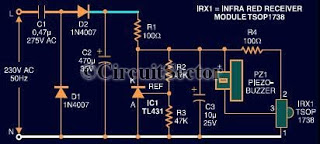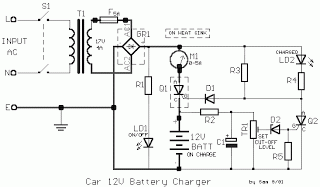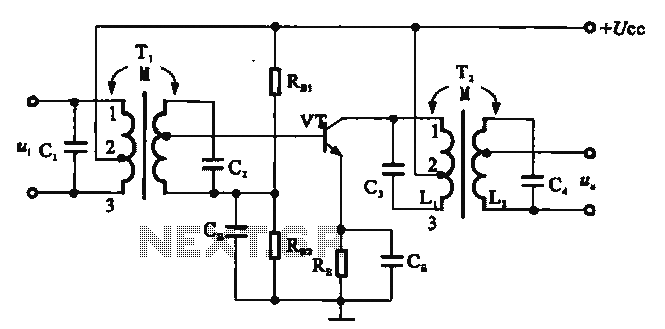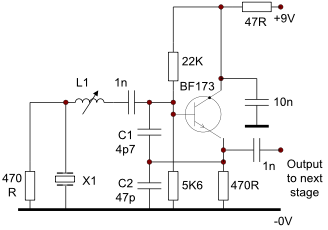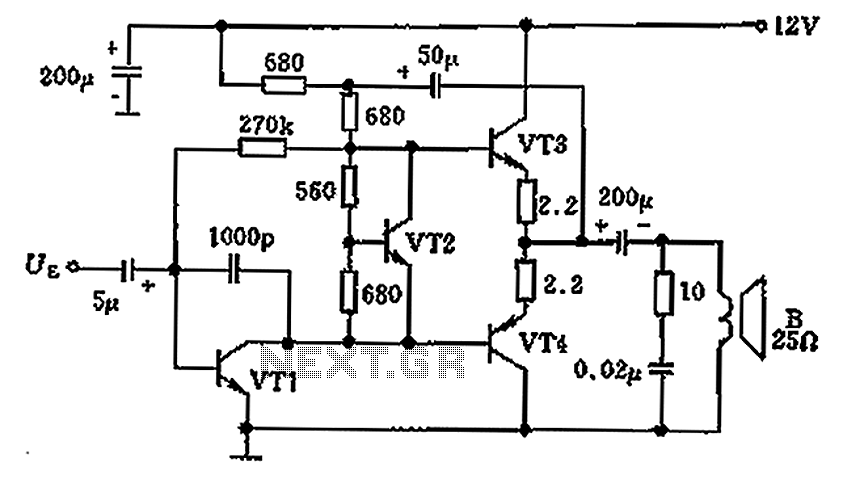
FM Modulator Circuit
The FM modulator circuit, which utilizes frequency modulation, is constructed using a Motorola MC1648P oscillator. Two varactors, specifically Motorola MV-209, are employed to modulate the frequency of the oscillator. A 5000-ohm potentiometer is incorporated to bias the varactors for optimal linearity. The output frequency is approximately 100 MHz and can be adjusted by modifying the inductance value. The frequency can vary by as much as 10 MHz on either side. The output level of the modulator is -5 dBm. In this FM modulator prototype, the varactor bias was set at 7.5V for the best linearity, although this value may differ with other varactor types. The circuit features a coil with two tuning diodes (MV209, with alternatives like two BB105 diodes also being suitable). The MC1648 chip functions as a stabilizer, regulated by a 5V zener diode. The circuit has demonstrated stability even when powered by a 9V regulator. However, it is important to note that without the chip and an appropriate filter, the circuit may produce harmonics. The effective range of this modulator is limited, likely not exceeding one room. The output power is minimal, in the range of a few milliwatts, which could potentially be amplified.
The FM modulator circuit is designed for frequency modulation applications, utilizing the Motorola MC1648P as the primary oscillator component. This chip is known for its stability and ability to generate a reliable output frequency. The incorporation of two varactor diodes, specifically the MV-209, allows for effective frequency modulation by varying the capacitance and thus altering the frequency of the oscillator. The use of a 5000-ohm potentiometer provides a means to bias the varactors, ensuring the circuit operates within an optimal linearity range, which is crucial for achieving a clean and distortion-free output.
The output frequency of the modulator is centered around 100 MHz, with a tuning range of approximately ±10 MHz, allowing for flexibility in the transmission frequency. The output level is specified at -5 dBm, indicating a low power level suitable for short-range applications. The design also includes a coil and tuning diodes, which play a vital role in the tuning process. Alternatives to the MV-209, such as BB105 diodes, can be utilized, providing options for varying the circuit's performance characteristics.
Stability is enhanced by the MC1648 chip, which is regulated using a 5V zener diode. This regulation is essential for maintaining consistent performance, especially when powered by a 9V supply. However, it's important to acknowledge that without proper filtering, the circuit may produce unwanted harmonics, which can degrade the quality of the transmitted signal. Consequently, additional filtering components may be necessary to ensure compliance with transmission standards and to minimize interference with other devices.
The effective range of the FM modulator is limited, typically confined to a single room, making it suitable for personal use or small-scale applications. The output power, while low, can be amplified if necessary, allowing for broader transmission capabilities depending on the requirements of the application. Overall, this circuit serves as a foundational model for those interested in exploring FM modulation and radio frequency transmission.The FM modulator circuit (frequency modulation) is built with a Motorola MC1648P oscillator. Two varactors, Motorola MV-209 are used to frequency modulate the oscillator. The 5000 © potentiometer is used to bias the varactors for the best linearity. The output frequency of approximately 100 MHz can be adjusted by changing the value of the inducto r. The output frequency can vary as much 10 MHz on each side. The output level of the modulator is -5 dBm. In this fm modulator prototype the varactor bias was 7. 5V for the best linearity but this could be different with other varactors. Hi folks, for those of you who want to look at a good site, i suggest (ultimate site for learners and experienced alike. ) Dont send him silly questions though. From a one tranny circ. to more elaborate transmitters such as V7b and v7 As you can see above, there is a coil with two tuning diodes(mv209, 2 x bb105 or similar may work too) (find, the veronica 1 watt guys, similar tuning deal) the mc1648 chip is a stabiliser type chip regulated by the 5v zener, although you will find that this was quite a stable circuit without if the circuit ran off say a 9v regulator, the earliest model i can think of was a kids c.
b circuit and then the 3w pantek came from that (good sound, rubbish harmonics but stable). This is prone to harmonics with out the chip and a filter though. This will not propogate more than one room i would say. I see no amplification either. This should put out the few miliwatts that could be amplified. 🔗 External reference
The FM modulator circuit is designed for frequency modulation applications, utilizing the Motorola MC1648P as the primary oscillator component. This chip is known for its stability and ability to generate a reliable output frequency. The incorporation of two varactor diodes, specifically the MV-209, allows for effective frequency modulation by varying the capacitance and thus altering the frequency of the oscillator. The use of a 5000-ohm potentiometer provides a means to bias the varactors, ensuring the circuit operates within an optimal linearity range, which is crucial for achieving a clean and distortion-free output.
The output frequency of the modulator is centered around 100 MHz, with a tuning range of approximately ±10 MHz, allowing for flexibility in the transmission frequency. The output level is specified at -5 dBm, indicating a low power level suitable for short-range applications. The design also includes a coil and tuning diodes, which play a vital role in the tuning process. Alternatives to the MV-209, such as BB105 diodes, can be utilized, providing options for varying the circuit's performance characteristics.
Stability is enhanced by the MC1648 chip, which is regulated using a 5V zener diode. This regulation is essential for maintaining consistent performance, especially when powered by a 9V supply. However, it's important to acknowledge that without proper filtering, the circuit may produce unwanted harmonics, which can degrade the quality of the transmitted signal. Consequently, additional filtering components may be necessary to ensure compliance with transmission standards and to minimize interference with other devices.
The effective range of the FM modulator is limited, typically confined to a single room, making it suitable for personal use or small-scale applications. The output power, while low, can be amplified if necessary, allowing for broader transmission capabilities depending on the requirements of the application. Overall, this circuit serves as a foundational model for those interested in exploring FM modulation and radio frequency transmission.The FM modulator circuit (frequency modulation) is built with a Motorola MC1648P oscillator. Two varactors, Motorola MV-209 are used to frequency modulate the oscillator. The 5000 © potentiometer is used to bias the varactors for the best linearity. The output frequency of approximately 100 MHz can be adjusted by changing the value of the inducto r. The output frequency can vary as much 10 MHz on each side. The output level of the modulator is -5 dBm. In this fm modulator prototype the varactor bias was 7. 5V for the best linearity but this could be different with other varactors. Hi folks, for those of you who want to look at a good site, i suggest (ultimate site for learners and experienced alike. ) Dont send him silly questions though. From a one tranny circ. to more elaborate transmitters such as V7b and v7 As you can see above, there is a coil with two tuning diodes(mv209, 2 x bb105 or similar may work too) (find, the veronica 1 watt guys, similar tuning deal) the mc1648 chip is a stabiliser type chip regulated by the 5v zener, although you will find that this was quite a stable circuit without if the circuit ran off say a 9v regulator, the earliest model i can think of was a kids c.
b circuit and then the 3w pantek came from that (good sound, rubbish harmonics but stable). This is prone to harmonics with out the chip and a filter though. This will not propogate more than one room i would say. I see no amplification either. This should put out the few miliwatts that could be amplified. 🔗 External reference

